Study MBBS in Philippines for Indian Students: 2025 Fee Structure, Course Duration, and Top Universities
MBBS in Philippines is a highly preferred choice for Indian students aiming to pursue MBBS abroad in a country known for its US-based curriculum, English-medium instruction, and high FMGE success rate. With over 10,000 Indian students already enrolled, MBBS in Philippines for Indian Students offers excellent value for money through its modern infrastructure, global recognition, and strong clinical exposure in affiliated hospitals. The MBBS in Philippines fees are comparatively affordable, ranging between ₹20 to ₹35 lakhs for the entire course. Renowned institutions like AMA School of Medicine, University of Perpetual Help, Davao Medical School Foundation, and Bicol Christian College of Medicine offer high-quality education with minimal donation and full English support. The course duration includes the BS+MD program, aligned with international standards and especially designed to ease PG transition to the USA, UK, and India. This article provides detailed insights on the Philippines MBBS eligibility criteria, admission process, duration, food and hostel facilities, and how University Insights helps Indian students with smooth and direct admission to top medical universities in the Philippines for the 2025–26 intake.
About Philippines
Studying MBBS in the Philippines has become increasingly popular among students who wish to study medicine abroad. The Philippines is known for its high-quality medical education and affordable costs, making it one of the leading medical destinations for Indian students.
Medical Degree Recognition: The medical degree awarded by Philippines medical universities is widely accepted across the world. Graduates from these institutions can pursue medical practice or higher studies in countries like the United States, Canada, and India.
Low Fees for High-Quality Medical Studies: Compared to other nations offering MBBS in abroad, the Philippines provides a good balance of quality education and low fees, attracting many Indian students.
Duration of the MBBS Program: The MBBS course duration in the Philippines is typically 6 years, which includes 5 years of academic study and 1 year of internship. This structure helps students gain comprehensive knowledge and practical experience before entering the medical profession.
| Category | Details |
|---|---|
| Capital | Manila |
| Official Language | Filipino (Tagalog) and English |
| Currency | Philippine Peso (PHP) |
| Number of Universities | 40+ Universities Offering MBBS or Equivalent Courses |
| Average Tuition Fees for MBBS | Starting from ₹5,00,000 per year (~6000 USD) |
| Cost of Living in the Philippines | ₹15,000 – ₹25,000 per month |
| Minimum and Maximum Temperature | 21°C (Winter) – 38°C (Summer) |
| Exchange Rate to INR | 1 PHP ≈ 1.45 INR (subject to change) |
| Climate | Tropical, with Wet Season (June-November) and Dry Season (December-May) |
The Philippines is a Southeast Asian country known for its tropical climate, diverse culture, and friendly locals. It is home to several medical colleges in the Philippines that have become a top choice for international students, including those from India.
Philippines Offer:
World-class medical education.
Globally recognized MBBS degree.
Low tuition fee compared to other study destinations.
Medical Council of India Approval: Many medical universities in the Philippines are approved by the MCI, which allows Indian students to return to India and practice as licensed doctors after clearing the Foreign Medical Graduates Examination (FMGE).
Cultural Insights and Geographical Overview for Students In Philippines Pursuing Medicine in the Philippines
Understanding the culture and environment is essential for students who wish to study medicine in the Philippines. Here’s a look at some key aspects:
Language and Communication: English is widely spoken in the Philippines, making it easy for international students to adapt. This is particularly beneficial for medical studies, as students do not face language barriers during their course.
Student Life and Community:
The Philippines is known for its warm hospitality and vibrant community life. Students from different backgrounds feel welcomed and integrated into the local culture.
The country’s diverse cultural heritage offers international students opportunities to explore festivals, cuisines, and traditions.
Geographical Insights:
The Philippines is an archipelago consisting of over 7,000 islands, offering a mix of urban and rural settings for medical studies.
Major cities like Manila, Cebu, and Davao host some of the top medical universities and colleges in the Philippines, providing students with access to well-equipped facilities and hospitals for practical training.
The Educational System for Studying MBBS in Philippines 2025
The Philippines’ medical education system is structured to provide a comprehensive learning experience for medical aspirants. Here’s an overview:
High-Quality Medical Education: The country is known for its rigorous academic standards, making it an attractive destination for students who wish to study MBBS abroad.
Course Structure:
Pre-Medicine (BS Program): The MBBS program in the Philippines often starts with a 1-2 year pre-medical course, known as the Bachelor of Science (BS) program.
MD Program: After completing the BS course, students progress to the 4-year Doctor of Medicine (MD) program, which is equivalent to the MBBS course.
Clinical Rotations: The final year of the MD program involves clinical rotations, where students get hands-on experience in hospitals affiliated with their medical schools in the Philippines.
Accreditation and Quality Assurance: Medical schools in the Philippines are regulated by the Commission on Higher Education (CHED), ensuring that the degree in the Philippines meets international standards.
Want To Study in Philippines?

Why Study MBBS College In the Philippines 2025-26?
The Philippines is one of the most popular destinations for students who wish to pursue MBBS abroad, especially for Indian medical aspirants. The country offers a combination of high-quality education, affordable fees, and a welcoming environment, making it an ideal choice for medical studies. The medical education in the Philippines is designed to match global standards, ensuring that students receive a comprehensive understanding of the medical course. Additionally, the use of English as a medium of instruction makes it easier for students from diverse backgrounds to adapt.
The MBBS in Philippines has become particularly appealing due to its similarity to the medical curriculum in India, which helps students prepare for licensure exams like the FMGE (Foreign Medical Graduates Examination). The degrees awarded by medical colleges in the Philippines are recognized by international bodies, allowing graduates to practice medicine in various countries, including India.
Affordability:
The college in Philippines offers low tuition fees, making it a cost-effective option compared to other MBBS destinations.
The overall cost of living in the Philippines is also lower, providing students with a budget-friendly study experience.
Quality of Education:
The medical education in the Philippines is known for its emphasis on practical knowledge and hands-on training.
Medical universities in the Philippines are equipped with modern facilities and experienced faculty members.
Global Recognition:
Degrees from medical colleges in the Philippines are recognized by international organizations such as the World Health Organization (WHO) and the Medical Council of India (MCI).
This ensures that students in Philippines can practice medicine globally after clearing the necessary licensure exams.
Cultural Compatibility:
The Philippines is one of the few countries with cultural similarities to India, making it easier for Indian students to adjust to their new environment.
The diverse and welcoming nature of the students in Philippines helps create a supportive learning community.
Want To Study in Philippines?

Study MBBS in Philippines for Indian Students And Medical Colleges In Philippines 2025-26
Supportive Environment for Indian Students:
The students to study MBBS in the Philippines benefit from an inclusive and supportive environment, with numerous Indian students already pursuing their education there.
Indian food is readily available in major cities, making it easier for Indian students to feel at home.
Clinical Exposure and Internship Opportunities:
Medical universities in the Philippines provide extensive clinical exposure through affiliated hospitals, allowing students to gain hands-on experience.
The final year of the medical course includes a mandatory internship, which helps students prepare for their future careers in the medical profession.
The MBBS in Philippines has become a top choice for Indian medical students due to its blend of high-quality education and affordable tuition fees. Indian medical students are drawn to the Philippines for its English-based curriculum, which helps in better understanding complex medical concepts. The best medical colleges in Philippines provide a conducive environment for learning, with a curriculum that aligns closely with that of Indian medical schools.
The students to study MBBS in the Philippines benefit from an education system that emphasizes clinical exposure and practical training. The course structure includes pre-medical studies, followed by the MD program, which is equivalent to the MBBS degree. This helps students who wish to study gain a solid foundation in medicine in Philippines before stepping into the professional field.
Course Duration and Structure:
The medical course in the Philippines typically lasts for 6 years, which includes a 1-2 year pre-medical course and a 4-year MD program.
The curriculum is designed to provide a balance between theoretical knowledge and clinical practice.
Top MBBS Colleges:
University of Santo Tomas (UST)
Davao Medical School Foundation (DMSF)
AMA School of Medicine
Cebu Institute of Medicine
Some of the best medical colleges in Philippines include:
These institutions are known for their rigorous academic standards and well-equipped facilities.
Want To Study in Philippines?

Admission Process for MBBS in Philippines 2025-26
The process to pursue MBBS in the Philippines is structured to accommodate international students, making it a popular choice for those seeking affordable and high-quality medical education. The medical universities in the Philippines offer a straightforward admission process, but it is crucial for prospective students to understand the requirements and procedures to ensure a smooth application. Here’s a comprehensive guide on the admission process, eligibility criteria, necessary documents, and visa requirements.
Eligibility Criteria and Required Documents for MBBS Admission in the Philippines 2025-26
To pursue MBBS in the Philippines, applicants must meet specific eligibility criteria and submit the necessary documentation to secure a seat in medical universities in the Philippines. The Philippines is quite known for its inclusive and student-friendly admission policies, which attract many international students.
- Eligibility Criteria:
- Must have completed 10+2 or equivalent from a recognized board.
- A minimum of 50% marks in Physics, Chemistry, and Biology is required for general category students.
- For reserved category students (SC/ST/OBC), a minimum of 40% marks in the same subjects is required.
- Age Requirement: Applicants must be at least 17 years old by December 31st of the year of admission.
- NEET 2025 Qualification:
- 50th percentile for General Category (720-162 marks).
- 40th percentile for SC/ST/OBC categories (161-127 marks).
- NEET is mandatory for Indian students intending to return and practice in India, as per National Medical Commission (NMC) regulations.
- NEET 2025 Qualification:
- English Proficiency: Since the medical universities in the Philippines conduct courses in English, students must have a basic understanding of the language.
- Required Documents:
- Completed application form of the chosen university.
- Passport-sized photographs (as per university specifications).
- Valid passport with a minimum of 18 months validity.
- 10th and 12th grade mark sheets and certificates.
- NEET scorecard.
- Birth certificate.
- Medical fitness certificate.
- Police clearance certificate.
- Proof of financial capability (bank statements or affidavits).
| Eligibility Criteria | Details |
| Minimum Age | 17 years |
| Educational Qualification | 50% in Physics, Chemistry, Biology (General Category) |
| NEET Qualification | Mandatory for Indian students |
| Language Requirement | Proficiency in English |
| Required Documents | Passport, educational certificates, NEET scorecard, etc. |
Want To Study in Philippines?

Application Process and Deadlines for MBBS Admission Top Medical Universities in Philippines 2025
The study in Philippines process requires students to follow the application procedure of their chosen university. It is crucial to adhere to the timelines and ensure that all steps are completed accurately for a successful admission.
Step-by-Step Application Process:
Step 1: Research and Select a University: Choose a university from the list of medical universities in the Philippines that aligns with your educational goals and budget.
Step 2: Fill Out the Application Form: Visit the university’s official website and fill out the online application form. Attach all required documents such as mark sheets, passport, and photographs.
Step 3: Receive Offer Letter: After reviewing the application, the university will issue an offer letter if the student meets the criteria. This process typically takes 2-4 weeks.
Step 4: Pay the Admission Fee: Once the offer letter is received, students must pay the required admission fee to confirm their seat.
Step 5: Apply for Visa: Start the visa application process as soon as the admission is confirmed (see below for detailed visa requirements).
Step 6: Book Flights and Arrange Accommodation: After securing the visa, students should plan their travel to the Philippines and arrange accommodation either through the university or independently.
Application Deadlines:
Most medical universities in the Philippines have two intakes: June-July and November-December.
Students are advised to apply at least 3-4 months before the desired intake to allow ample time for visa processing and other arrangements.
Application Process Step | Details |
Research and University Selection | Choose from the top medical universities |
Application Form Submission | Online form with required documents |
Offer Letter and Admission Fee Payment | 2-4 weeks processing time |
Visa Application | Begin after admission confirmation |
Intakes | June-July, November-December |
Visa Requirements for MBBS Students in the Philippines
Obtaining a student visa is a crucial part of the process for students to study MBBS in the Philippines. The visa application process requires careful preparation to ensure that students meet all the requirements set by the Philippine government.
Types of Visas:
9(F) Student Visa: This is the standard visa for international students pursuing higher education in the Philippines, including those enrolled in medical universities in the Philippines.
Special Study Permit (SSP): For short-term courses or students below the age of 18, an SSP may be required initially before transitioning to a full student visa.
Visa Application Requirements:
Valid passport with a minimum of 18 months validity.
Original and photocopy of the acceptance letter from a recognized MBBS college in the Philippines.
Proof of financial capacity (bank statements or financial affidavits).
Police clearance certificate.
Medical examination certificate, including tests for HIV and other infectious diseases.
Visa application form duly completed.
Two passport-sized photographs.
Visa Processing Time:
Visa processing can take anywhere between 4-6 weeks, depending on the embassy’s workload.
It is advisable for students to apply for the visa well in advance to avoid any last-minute delays.
Visa Type | Purpose |
9(F) Student Visa | For long-term study in medical universities in the Philippines |
Special Study Permit (SSP) | For students below 18 or for short-term courses |
Required Documents for Visa | Acceptance letter, passport, financial proof, police clearance |
Processing Time | 4-6 weeks |
By adhering to these guidelines and ensuring that all documentation is in order, students can pursue MBBS in the Philippines smoothly. With its recognized national medical education standards, affordable fees, and supportive environment, the Philippines is quite an ideal destination for aspiring doctors.
Want To Study in Philippines?

MBBS Of Medical Universities In Philippines Fee Structure and Costs 2025-26
The medical universities in Philippines have become a preferred choice for international students, especially those from India, due to the balance of affordability and quality in their educational offerings. Understanding the fee structure and costs involved in pursuing MBBS in the Philippines is essential for effective financial planning. Below is a detailed look at the various expenses, including tuition fees, living costs, and hidden expenses, to help students prepare for their MBBS in Philippines 2025-26.
MBBS in Philippines Fees for Tuition and Other Expenses
The tuition fees for pursuing MBBS in the Philippines vary based on the university, location, and facilities provided. The overall fee structure is more affordable compared to other countries, making it an attractive destination for medical education.
Tuition Fees:
Private Medical Universities: Tuition fees range from ₹3,50,000 to ₹6,50,000 per year, depending on the institution’s rank and infrastructure.
Public Medical Universities: Typically, the fees are lower in public universities, ranging from ₹2,00,000 to ₹4,00,000 per year.
Additional Expenses:
Accommodation: Hostel facilities are provided by most universities at an additional cost of around ₹70,000 to ₹1,20,000 per year.
Food and Dining: Monthly expenses for food range between ₹10,000 and ₹15,000, depending on dietary preferences.
Health Insurance: Annual health insurance premiums for international students can cost around ₹20,000 to ₹30,000.
University Type | Tuition Fee (per year) | Accommodation Cost (per year) | Food (per month) | Health Insurance (per year) |
Private Medical University | ₹3,50,000 – ₹6,50,000 | ₹70,000 – ₹1,20,000 | ₹10,000 – ₹15,000 | ₹20,000 – ₹30,000 |
Public Medical University | ₹2,00,000 – ₹4,00,000 | ₹70,000 – ₹1,00,000 | ₹10,000 – ₹15,000 | ₹20,000 – ₹30,000 |
Financial Costs of Studying Medicine in the Philippines
In addition to tuition, students need to consider the overall financial costs of studying medicine in the Philippines. These include various living expenses, transportation costs, and personal expenditures that contribute to the total cost of living.
Living Expenses:
Housing: Students who opt for off-campus housing may find apartments ranging from ₹15,000 to ₹25,000 per month depending on location and amenities.
Utilities: Monthly utilities such as electricity, water, and internet can add another ₹5,000 to ₹7,000.
Travel Expenses:
Local Transportation: Public transport like buses and jeepneys costs about ₹1,000 to ₹2,000 per month. Some students may choose to use ride-sharing services, which can be more expensive.
Air Travel: Flights between India and the Philippines cost approximately ₹25,000 to ₹50,000 per trip.
Books and Study Materials: Students need to budget around ₹10,000 to ₹15,000 annually for purchasing medical textbooks and supplies.
Expense Type | Cost (Approximate) |
Off-Campus Housing | ₹15,000 – ₹25,000 per month |
Utilities (electricity, etc.) | ₹5,000 – ₹7,000 per month |
Local Transportation | ₹1,000 – ₹2,000 per month |
Air Travel (India-Philippines) | ₹25,000 – ₹50,000 per trip |
Books and Study Materials | ₹10,000 – ₹15,000 per year |
Detailed Breakdown of MBBS in Philippines Fee Structure
Understanding the specific components of the MBBS in Philippines fee structure is crucial for students to budget accurately. The following breakdown provides insights into where the major expenses lie:
Yearly Breakdown of Costs:
Year 1: Includes initial expenses such as admission fees (₹50,000 to ₹1,00,000), tuition fee, and initial setup for accommodation.
Years 2-5: Main expenses include tuition, accommodation, and food, with costs gradually increasing due to inflation.
Internship Year: Students may need to budget for additional travel and living expenses during clinical rotations.
Year | Tuition Fee | Admission Fee | Living Costs | Books and Materials | Total Estimated Cost |
Year 1 | ₹4,00,000 | ₹75,000 | ₹1,50,000 | ₹15,000 | ₹6,40,000 |
Year 2 | ₹4,00,000 | – | ₹1,50,000 | ₹10,000 | ₹5,60,000 |
Year 3 | ₹4,00,000 | – | ₹1,50,000 | ₹10,000 | ₹5,60,000 |
Year 4 | ₹4,00,000 | – | ₹1,50,000 | ₹10,000 | ₹5,60,000 |
Internship Year | ₹4,00,000 | – | ₹1,80,000 | ₹10,000 | ₹5,90,000 |
Hidden Costs for MBBS Students medical schools in the Philippines
While the primary costs are straightforward, there are several hidden costs for MBBS students in the Philippines that should be considered when planning the budget:
Visa Renewal Fees: Student visas require periodic renewal, costing around ₹10,000 to ₹15,000 each time.
Laboratory Fees: Some universities charge separate fees for lab usage, which can amount to ₹5,000 to ₹10,000 per semester.
Extracurricular and Club Activities: Participation in student clubs, conferences, and medical seminars may involve additional fees.
Emergency Medical Expenses: Although health insurance covers most needs, there may be out-of-pocket costs for certain medical treatments.
Financial Planning And Philippines Offer for MBBS Admission in Philippines
Proper financial planning for MBBS admission in Philippines can help students manage their expenses effectively and avoid financial stress during their studies:
Scholarships and Financial Aid:
Some medical universities in Philippines offer scholarships to international students based on merit or need. These can significantly reduce tuition costs.
External scholarships and educational loans are also available through Indian banks and institutions for those looking to pursue MBBS in Philippines.
Budgeting Tips:
Plan for at least 10% extra in your budget to account for unexpected expenses.
Opt for shared accommodation to reduce housing costs.
Use student discounts for public transportation and other services.
Financial Planning Aspect | Details |
Scholarships | Available for merit and need-based students |
Educational Loans | Offered by Indian banks for MBBS courses abroad |
Budget Cushion | Plan for 10% extra to cover unforeseen costs |
Shared Accommodation | Can save up to 30% on housing expenses |
Use of Student Discounts | Helps reduce daily travel and meal costs |
Want To Study in Philippines?

Top Medical Colleges for MBBS in Philippines 2025-26
The Philippines is home to several medical universities in Philippines that provide high-quality education, making it a preferred destination for students to study medicine. These institutions are known for their robust academic structure, experienced faculty, and state-of-the-art facilities. Here is a list of some of the best medical colleges in the Philippines for Indian students looking to pursue MBBS.
Best Medical Colleges in Philippines for Indian Students
University Name | Location | Recognition | Approximate Tuition Fee (per year) |
University of Santo Tomas (UST) | Manila | MCI, WHO | ₹6,00,000 |
University of the Philippines (UP) | Manila | MCI, CHED | ₹5,50,000 |
Davao Medical School Foundation (DMSF) | Davao City | MCI, WHO, FAIMER | ₹5,00,000 |
Cebu Institute of Medicine | Cebu City | MCI, WHO | ₹4,00,000 |
AMA School of Medicine | Manila | MCI, WHO, CHED | ₹4,50,000 |
Want To Study in Philippines?

Advantages of Studying MBBS in the Philippines 2025-26
The Philippines is quite a favorable destination for international students, particularly those from India, to pursue MBBS. The country’s medical education system aligns with global standards, and its emphasis on practical learning makes it ideal for medical studies. The language of instruction is English, which facilitates smooth communication and understanding for students from diverse backgrounds.
The medical universities in the Philippines offer a curriculum that is similar to that of India, enabling Indian students to prepare for licensing exams such as the FMGE (Foreign Medical Graduates Examination). Additionally, the affordability of the education system, combined with the availability of modern facilities, makes it a cost-effective option for those seeking high-quality medical education in the Philippines.
Cost-Effective Education: The cost of medical studies in the Philippines is significantly lower than in many Western countries, without compromising the quality of education.
Global Recognition: Medical degrees from the best medical colleges in the Philippines are recognized by international bodies such as the World Health Organization (WHO) and the Medical Council of India (MCI).
Extensive Clinical Exposure: Students gain practical experience in hospitals through clinical rotations, which is a key aspect of the medical course.
Cultural Affinity: The Philippines shares cultural similarities with India, making it easier for Indian students to adapt to the environment.
High Success Rate in Licensing Exams: Graduates from medical colleges in Philippines often perform well in the FMGE and other licensing exams, making it easier to practice in India.
MBBS Course Details and Curriculum in the Philippines 2025-26
The MBBS curriculum and course structure in Philippines is designed to provide a comprehensive understanding of medical science, with a strong emphasis on practical training. The course is equivalent to the MD (Doctor of Medicine) program in the Philippines and follows international standards.
MBBS Curriculum and Course Structure in Philippines
The medical education in the Philippines is divided into two main stages: Pre-Medical (BS program) and MD (equivalent to MBBS). The structure focuses on building a strong foundation in medical sciences and providing extensive clinical exposure.
Pre-Medical (BS Program):
Duration: 1-2 years
Focus: Basic sciences including Biology, Chemistry, and Physics, which prepare students for the MD program.
MD Program:
Duration: 4 years, equivalent to an MBBS degree.
Includes theoretical knowledge, practical training, and clinical rotations.
Students engage in anatomy, physiology, biochemistry, pathology, pharmacology, and community medicine during the initial years.
MBBS Course Duration in the Philippines
The MBBS course duration in the Philippines is typically 6 years, including pre-medical studies and the main MD program.
1-2 Years: Pre-Medical BS Program.
4 Years: MD program, including clinical rotations in affiliated hospitals.
1 Year: Internship for practical exposure and training in various medical fields.
Course Stage | Duration | Focus Area |
Pre-Medical (BS) | 1-2 years | Basic Sciences |
MD (MBBS Equivalent) | 4 years | Clinical and Theoretical Training |
Internship | 1 year | Hands-on Experience in Hospitals |
Academic Support for MBBS Students in Medical Schools of the Philippines
The medical universities in the Philippines provide strong academic support systems for their students, ensuring a conducive environment for learning.
Mentorship Programs: Personalized guidance from experienced faculty members.
Tutorials and Workshops: Regular workshops and tutorials to clarify complex medical concepts.
Access to Medical Journals: Subscription to various national and international medical journals for research.
Student Support Services: Counseling and academic advisory services to help students navigate their courses.
Research and Laboratory Facilities in Medical Colleges in the Philippines
Research is an integral part of medical education in the Philippines. Medical universities in Philippines are equipped with state-of-the-art laboratories and research centers, providing students the opportunity to explore various aspects of medical science.
Modern Laboratories: Equipped with advanced equipment for studying anatomy, physiology, and pathology.
Research Opportunities: Collaboration with local hospitals and research institutes for clinical studies.
Dedicated Research Centers: Focused on areas like tropical diseases, pharmacology, and public health.
Online Learning Resources for Medical Students in the Philippines
With advancements in digital education, medical universities in the Philippines have incorporated online learning platforms to enhance the learning experience.
Virtual Classrooms: Interactive sessions for theoretical subjects.
Online Libraries: Access to a wide range of digital textbooks and reference materials.
Webinars and E-Lectures: Regular webinars on current medical research and practices.
Use of Technology in MBBS Education in the Philippines
The use of technology in MBBS education in the Philippines has been instrumental in modernizing the learning process.
Simulation Labs: High-fidelity simulation models for hands-on practice in surgery and emergency medicine.
Telemedicine Training: Prepares students for digital healthcare services, which are becoming increasingly important globally.
Digital Anatomy Labs: 3D visualization tools for better understanding of human anatomy and physiology.
Want To Study in Philippines?

MBBS Syllabus in Philippines for 2025-26
The MBBS curriculum in the Philippines is structured to provide students with a comprehensive understanding of medical sciences, clinical skills, and ethical practices. It follows a system that integrates theoretical knowledge with practical application, making it suitable for students aiming for a global medical career. Here is a detailed overview of the syllabus and training structure for the MBBS in Philippines for the academic year 2025-26.
Key Subjects and MBBS Curriculum in the Philippines
The key subjects and MBBS curriculum in the Philippines are designed to build a strong foundation in medical sciences during the initial years, with advanced subjects and clinical training in later stages.
Pre-Medical Phase (BS Program):
Biology
Chemistry
Physics
Psychology
General Anatomy
Duration: 1-2 years
Focuses on fundamental subjects to prepare students for the MD program.
Subjects include:
MD Program (Equivalent to MBBS):
Anatomy
Physiology
Biochemistry
Microbiology
Pathology
Pharmacology
Internal Medicine
Pediatrics
Surgery
Obstetrics and Gynecology
Psychiatry
Includes hands-on training in affiliated hospitals.
Students rotate through various departments like surgery, pediatrics, and emergency medicine.
Year 1 and 2 (Basic Medical Sciences):
Year 3 (Clinical Sciences):
Year 4 (Clinical Rotations):
MBBS in Abroad (Philippines) Syllabus Overview
The MBBS in Philippines syllabus overview emphasizes both theoretical learning and practical exposure. The program is aligned with international standards, ensuring that students are well-prepared for global medical practice.
Theory Classes: Lectures and discussions on core subjects like anatomy, biochemistry, and pathology during the first two years.
Laboratory Work: Regular lab sessions to understand biological processes, chemical reactions, and microscopic studies.
Clinical Training: From the third year, students start engaging in patient care through supervised clinical rotations.
Assessment and Evaluation:
Regular internal assessments through quizzes, mid-term exams, and practical exams.
Final year includes comprehensive examinations that test both theoretical knowledge and practical skills.
Internship Structure for MBBS Students Medicine in Philippines
The internship structure for MBBS students in the Philippines is a crucial component of their medical education, providing real-world clinical experience.
Duration: 1 year (Part of the MD program)
Structure:
Clinical Rotations: Students are assigned to different hospital departments such as internal medicine, surgery, pediatrics, obstetrics and gynecology, and community medicine.
Supervised Practice: Interns work under the supervision of experienced physicians and interact directly with patients.
Case Studies: Involves presenting case reports and participating in hospital rounds.
Community Medicine: Some programs include community service as part of the internship, allowing students to understand public health issues.
Licensing Exams for Medical School Graduates in the Philippines
After completing their MBBS in Philippines, graduates must pass certain licensing exams to practice medicine.
Physicians Licensure Examination (PLE): Mandatory for local practice in the Philippines.
Foreign Medical Graduates Examination (FMGE): Required for Indian students who wish to practice in India. Passing this exam allows students to register with the Medical Council of India (MCI).
USMLE (United States Medical Licensing Examination): Graduates can take this exam if they plan to practice medicine in the United States.
IELTS/TOEFL: Required for students who plan to pursue further studies or medical practice in countries where English proficiency is required.
Ethical Practices in MBBS Education in the Philippines
The MBBS curriculum in the Philippines places significant emphasis on ethical practices, ensuring that future doctors understand the moral responsibilities associated with patient care.
Medical Ethics Courses: Integrated into the curriculum to teach students about patient confidentiality, informed consent, and professional behavior.
Case Discussions: Analyzing real-life scenarios to understand ethical dilemmas in the medical field.
Code of Conduct: Adherence to a strict code of conduct during clinical rotations and interactions with patients.
Sustainability Initiatives in Medical Colleges in the Philippines
Sustainability initiatives in medical colleges in the Philippines are becoming an integral part of the education system, focusing on environmentally friendly practices and community health.
Green Campuses: Many medical universities in the Philippines are adopting sustainable practices like energy-efficient buildings and waste management systems.
Community Health Programs: Collaboration with local communities for health education and preventive care.
Research on Public Health: Focused on tropical diseases and climate change-related health issues, preparing students to address global health challenges.
Integration of Sustainable Practices in Curriculum: Teaching students the importance of sustainability in healthcare settings, such as reducing waste in hospitals and promoting renewable energy sources in healthcare facilities.
Want To Study in Philippines?

Career Opportunities After MBBS in Philippines 2025-26
Completing an MBBS in the Philippines opens up various career pathways for graduates, ranging from clinical practice to research and higher studies. The country’s medical education system aligns with international standards, making MBBS graduates from the Philippines eligible for various opportunities both locally and globally. Below is a detailed overview of the career opportunities and challenges that graduates may encounter.
Job Prospects for MBBS Graduates from the Philippines
MBBS graduates from the Philippines have a range of job opportunities in both clinical and non-clinical fields. The medical degree obtained from medical universities in Philippines is recognized by many countries, facilitating employment across the globe.
Clinical Practice:
Graduates can work as general practitioners or medical officers in hospitals, clinics, and community health centers in the Philippines or their home countries.
Opportunities are available in both private and public healthcare sectors.
Teaching and Research:
Those with an interest in academia can join as lecturers or research assistants in medical schools or universities.
Research opportunities in areas like public health, tropical diseases, and pharmacology are particularly significant.
Global Job Opportunities:
MBBS graduates from the Philippines often find employment in countries like the United States, the United Kingdom, and the Middle East, provided they clear the respective licensing exams such as USMLE or PLAB.
Higher Studies and Specializations after MBBS in Philippines
After completing MBBS in the Philippines, graduates can pursue further specialization in various fields to enhance their knowledge and career prospects.
Postgraduate Programs:
Popular options include MD/MS in specializations such as Internal Medicine, Surgery, Pediatrics, and Obstetrics & Gynecology.
The duration of postgraduate studies typically ranges from 2 to 3 years.
Super-Specializations:
Fields like Cardiology, Neurology, Oncology, and Nephrology are available for those seeking to further refine their skills.
Masters in Public Health (MPH):
An MPH degree is ideal for those interested in public health policy, epidemiology, and health administration. It is a valuable addition for those aiming to work in NGOs or government health sectors.
Specialization | Duration | Potential Career |
MD/MS (General Specialties) | 2-3 years | Specialist Doctor, Hospital Consultant |
DM/MCh (Super-Specialties) | 3-4 years | Cardiologist, Neurologist, Oncologist |
MPH | 1-2 years | Public Health Expert, Health Policy Analyst |
Licensing Requirements for MBBS Graduates in the Philippines
For MBBS graduates from the Philippines to practice medicine, they must meet certain licensing requirements depending on the country where they wish to work.
Philippines Licensure:
Graduates need to pass the Physicians Licensure Examination (PLE) conducted by the Philippine Regulatory Commission.
The exam covers key areas like Internal Medicine, Surgery, Pediatrics, and Preventive Medicine.
Licensing in India:
Indian students must clear the Foreign Medical Graduates Examination (FMGE) to practice in India.
The FMGE is conducted by the National Board of Examinations (NBE) and requires a minimum of 50% to pass.
International Licensing:
USMLE: For graduates aiming to practice in the United States, passing the United States Medical Licensing Examination is essential.
PLAB: For practice in the UK, the Professional and Linguistic Assessments Board (PLAB) test is required.
Part-Time Work for MBBS Students in the Philippines
While pursuing MBBS in the Philippines, students often seek part-time work to support their living expenses or gain practical experience.
On-Campus Jobs:
Students can work as teaching assistants or participate in research projects led by faculty members.
University libraries, laboratories, and administrative departments also offer part-time positions.
Medical Internships:
Many students opt for internships in local clinics or hospitals during their studies, which provides practical exposure and a stipend.
Regulations for International Students:
International students must adhere to the rules set by their student visa, which may limit the number of hours they can work per week.
Placement Services in Medical Schools of the Philippines
Medical schools in the Philippines often provide placement services to assist students in finding job opportunities after graduation.
Career Counseling:
Universities have dedicated career counseling centers that help students explore job opportunities and prepare for interviews.
Job Fairs and Recruitment Events:
Medical universities in the Philippines organize annual job fairs where hospitals and healthcare organizations recruit new graduates.
Alumni Mentorship Programs:
Alumni networks help current students connect with professionals in the field, providing valuable insights and guidance for career advancement.
Alumni Networks of Medical Colleges in the Philippines
The alumni networks of medical colleges in the Philippines are a significant resource for recent graduates and current students.
Networking Opportunities:
Alumni events and meet-ups are organized to facilitate networking and professional connections.
Mentorship Programs:
Alumni often mentor current students, providing guidance on career choices and preparations for licensing exams.
Global Reach:
Alumni from medical universities in the Philippines hold positions in prestigious hospitals and institutions across the world, providing a valuable network for job placements.
Alumni Success Stories from MBBS Graduates in the Philippines
Many MBBS graduates from the Philippines have made significant achievements in their careers, serving as inspiration for future students.
Dr. Saba khan: Graduated from the University of Santo Tomas and is now a leading cardiologist in a major Manila hospital.
Dr. Ravi Kumar: An Indian graduate from Davao Medical School Foundation, who cleared the FMGE on his first attempt and is now practicing in a renowned hospital in Bangalore, India.
Dr. Rameez: Completed her MD from the University of the Philippines and is now pursuing further specialization in Neurology in the United States.
Challenges for International MBBS Students in the Philippines
While the Philippines offers numerous advantages for students to study MBBS, international students may face certain challenges during their stay.
Cultural Adjustment:
Adapting to local customs and lifestyle can be a challenge for some international students.
Language barriers in day-to-day interactions outside the university setting can also pose difficulties.
Financial Management:
Balancing the cost of living, tuition fees, and other expenses may require careful planning, especially for those without scholarships.
Licensing Exam Pressure:
Preparing for exams like the FMGE or USMLE while managing academic requirements can be stressful.
Visa and Documentation Issues:
Keeping up with visa renewals and ensuring compliance with immigration laws is essential for maintaining student status.
Want To Study in Philippines?

Comparing MBBS in Philippines vs. India 2025-26
Choosing between MBBS in the Philippines and India is a critical decision for medical aspirants. Each option comes with its unique set of advantages and challenges. Understanding the differences in terms of educational structure, career opportunities, and global recognition can help students make an informed choice.
Post-Graduation Opportunities for MBBS Graduates in the Philippines
Post-graduation opportunities are crucial for medical students looking to specialize after completing their MBBS degree. The medical universities in the Philippines offer a variety of pathways for further studies:
MD/MS Programs: Graduates can pursue specialization in various fields such as Internal Medicine, Surgery, Pediatrics, and more.
Higher Studies Abroad: Many MBBS graduates from the Philippines opt for postgraduate studies in countries like the United States, United Kingdom, and Australia after clearing respective licensing exams like USMLE or PLAB.
Residency Programs: The Philippines offers residency programs for graduates who wish to continue their medical education within the country. These programs provide in-depth training in specialized fields.
Research Opportunities: For those inclined towards academic and clinical research, the Philippines provides access to research institutions focusing on tropical diseases, community health, and public health.
Post-Graduation Path | Philippines | India |
MD/MS Specialization | Available in various fields | Available, highly competitive |
Residency Programs | Offered in both private and public hospitals | Available, competitive entrance exams required |
Higher Studies Abroad | Well-recognized degrees for US, UK, Australia | Recognized, but higher competition for seats |
Research Opportunities | Focus on tropical and community health | Focus on diverse research areas |
Global Recognition of MBBS Degree from the Philippines
The MBBS degree from the Philippines is recognized worldwide, making it a valuable qualification for students seeking a global career.
Medical Council of India (MCI): The degree is recognized by the MCI, which allows Indian students to practice in India after passing the FMGE.
World Health Organization (WHO): Many medical universities in the Philippines are listed in the WHO’s directory, which enhances the global acceptance of the degree.
USMLE and PLAB Eligibility: Graduates can sit for international licensing exams like the USMLE for practice in the United States and PLAB for the United Kingdom.
Wide Acceptance in Southeast Asia: The degree is also well-regarded in Southeast Asian countries, providing regional opportunities for practice and higher studies.
Benefits of Choosing MBBS in the Philippines Over India
There are several advantages of pursuing MBBS in the Philippines compared to India, particularly for Indian students seeking a balance between quality education and affordability.
Lower Cost of Education: The cost of MBBS in the Philippines is significantly lower than private medical colleges in India, making it an attractive option for budget-conscious students.
English-Medium Instruction: The medical universities in the Philippines use English as the medium of instruction, eliminating language barriers and making it easier for Indian students to adapt.
Higher Success Rate in FMGE: Indian students graduating from the Philippines often have a higher success rate in the FMGE compared to graduates from other countries due to the curriculum’s alignment with Indian medical education standards.
Shorter Admission Process: Admission to medical universities in the Philippines is typically less competitive than in India, where entrance exams like NEET have extremely high cut-off scores.
MBBS in Philippines vs. Other Countries 2025-26
When considering studying MBBS abroad, the Philippines is quite competitive compared to other popular destinations such as Russia, Ukraine, and China. Understanding the differences in curriculum, cost, and living conditions can help students decide why the Philippines might be the best fit for their needs.
Why Choose the Philippines for MBBS?
There are several reasons why the Philippines is one of the preferred destinations for students to pursue MBBS:
Cultural Compatibility: The Philippines shares cultural similarities with India, making it easier for Indian students to adjust to the environment.
Affordable Living Costs: Compared to Western countries, the cost of living in the Philippines is lower, which helps students manage their expenses better.
High-Quality Education: The medical education in the Philippines follows a curriculum similar to the United States, emphasizing practical training and clinical exposure.
Strategic Location: Being in Southeast Asia, the Philippines offers easy access to other Asian countries, which can be beneficial for students seeking regional opportunities in their medical careers.
Comparison of MBBS in the Philippines with Other Abroad Destinations
Comparing MBBS in the Philippines with other popular destinations like Russia, Ukraine, and China highlights the advantages of choosing the Philippines for medical studies.
Criteria | Philippines | Russia | Ukraine | China |
Language of Instruction | English | Russian (language courses needed) | Ukrainian/Russian | Chinese/English (varies by program) |
Cost of Education | ₹3,00,000 – ₹6,00,000 per year | ₹2,50,000 – ₹5,00,000 per year | ₹2,00,000 – ₹4,50,000 per year | ₹2,50,000 – ₹6,00,000 per year |
Living Costs | Moderate | Low to moderate | Moderate | Low to moderate |
Global Recognition | MCI, WHO, USMLE, PLAB | MCI, WHO | MCI, WHO | MCI, WHO, USMLE |
Climate Adaptability | Tropical, similar to India | Cold, challenging for some | Cold, requires adaptation | Varies (temperate to cold) |
FMGE Pass Rate | Higher due to aligned curriculum | Moderate | Moderate | Moderate |
Want To Study in Philippines?

Scholarships and Financial Aids for MBBS in Philippines 2025-26
Studying MBBS in the Philippines is a cost-effective choice compared to many other countries, but the expenses can still be significant for some students. Various scholarships and financial aids are available to help ease the financial burden and make medical education more accessible. Here is a detailed look at the options available and how to apply for them.
Scholarships for Medical Students in the Philippines
Numerous scholarships are available for medical students in the Philippines. These scholarships are offered by universities, government bodies, and private organizations to support students based on merit, need, or specific eligibility criteria.
University-Based Scholarships:
Many medical universities in the Philippines offer scholarships to students with excellent academic records or those demonstrating financial need.
Examples include the University of Santo Tomas Scholarship and Davao Medical School Foundation Merit Scholarship.
Government Scholarships:
CHED-Tulong Dunong Scholarship: Provided by the Commission on Higher Education (CHED) in the Philippines, it supports local and international students pursuing higher education.
Philippine Government Scholarships: Available for students from ASEAN countries, including India, these scholarships cover tuition fees and sometimes living expenses.
Private and NGO Scholarships:
Various NGOs and private foundations, such as the Philippine American Educational Foundation (PAEF), provide financial aid to international students.
Scholarships from Indian organizations like the Indian Council for Cultural Relations (ICCR) are also available for students pursuing studies abroad.
Financial Aid Options for Studying Medicine in the Philippines
In addition to scholarships, students have access to several financial aid options that can help cover the costs of studying medicine in the Philippines.
Education Loans:
Education loans are offered by both Indian and international banks to cover tuition fees, accommodation, and other living expenses.
Interest rates for these loans can vary, with repayment starting after the completion of the course.
Some popular options include loans from the State Bank of India (SBI), HDFC Bank, and Bank of Baroda.
Work-Study Programs:
Some universities in the Philippines offer work-study programs, allowing students to earn while studying by taking up roles such as teaching assistants or research aides.
Grants and Sponsorships:
Certain medical schools in the Philippines have partnerships with healthcare organizations that provide grants or sponsorships for students, particularly those interested in community health services.
Financial Aid Option | Description | Eligibility |
University Scholarships | Merit-based, need-based support from universities | High academic performance, financial need |
Government Scholarships | Support from the Philippine or Indian government | ASEAN students, Indian nationals |
Education Loans | Loans covering tuition and living expenses | Admission to a recognized medical college |
Work-Study Programs | Part-time work opportunities for students | Enrolled in a participating university |
Grants and Sponsorships | Support from private foundations and NGOs | Specific eligibility based on programs |
How to Apply for Scholarships to Study MBBS in the Philippines
The process for applying for scholarships to study MBBS in the Philippines involves several steps, including researching available scholarships, preparing documents, and meeting specific criteria.
Step 1: Research Available Scholarships:
Visit the websites of your target medical universities in the Philippines to check for scholarship announcements.
Explore external scholarship portals such as Study in the Philippines and Indian government websites for funding options.
Step 2: Prepare Required Documents:
Gather academic transcripts, letters of recommendation, financial statements, and a statement of purpose.
Some scholarships may require proof of acceptance into a medical program or a personal interview.
Step 3: Meet Eligibility Criteria:
Ensure you meet the academic and financial requirements specified by the scholarship provider.
Merit-based scholarships often require maintaining a certain GPA throughout the course.
Step 4: Submit Applications:
Complete the application forms accurately and submit them before the deadline. Make sure to include all required documents.
Keep a copy of your application for future reference.
Step 5: Follow Up:
Follow up with the scholarship committee if you do not receive a response within the specified time. This shows your commitment and interest.
Want To Study in Philippines?

Alternative MBBS Destinations for Indian Students in 2025
While the Philippines is a popular choice for Indian students, other countries also offer competitive medical education programs. Understanding the popular countries for studying medicine other than the Philippines can help students make informed decisions.
Popular Countries for Studying Medicine Other Than the Philippines
-
Russia: Known for its affordable medical education, Russia has a large number of medical universities that attract Indian students.
-
China: Chinese universities have gained a reputation for providing advanced facilities and practical exposure. The country offers low fees for international students.
-
Georgia: Emerging as a preferred destination due to its lower cost of living and shorter course duration compared to other European countries.
Best Options for MBBS Abroad Besides the Philippines
Choosing the right country for MBBS abroad depends on factors like budget, language preference, and climate adaptability. Here are some of the best options for MBBS abroad for Indian students:
-
Kazakhstan: Offers a shorter course duration of around 5 years with an affordable fee structure.
-
Kyrgyzstan: Known for its cost-effective education system, with several universities offering English-medium MBBS programs.
-
Bangladesh: Offers a curriculum similar to India, making it easier for Indian students to transition back home for practice.
-
Nepal: The proximity to India and similar cultural background make Nepal a popular choice for Indian students.
Pros and Cons of MBBS Destinations
Every MBBS destination has its own set of advantages and challenges. Understanding these can help students make an informed decision about where to study.
|
Country |
Pros |
Cons |
|
Affordable, English-medium, high FMGE pass rate |
Tropical climate may be difficult for some students |
|
|
Low tuition fees, rich cultural experience |
Harsh winters, language barriers outside of class |
|
|
European education, good clinical exposure |
Political instability in certain regions |
|
|
Advanced facilities, globally recognized degrees |
Language barrier, stringent regulations for international students |
|
|
Lower living costs, European lifestyle |
Limited opportunities for part-time work |
|
|
Shorter course duration, lower fees |
Less exposure to English-speaking environment |
Want To Study in Philippines?

Living Costs While Studying MBBS in the Philippines 2025-26
Understanding the living costs is essential for students planning to study MBBS in the Philippines. The overall expenses include accommodation, food, transportation, and other personal costs. Here is a detailed overview of what to expect while living as an MBBS student in the Philippines.
Student Life, Culture, and Lifestyle for Medical Students in the Philippines
The student life in the Philippines is vibrant, with a blend of academic rigor and opportunities for cultural immersion. The Philippines is known for its warm hospitality, making it easier for international students to adapt.
Culture and Social Life:
Filipinos are known for their friendly and welcoming nature, making it easy for international students to feel at home.
Festivals like Sinulog and Pahiyas provide a cultural insight into Filipino traditions.
Student Lifestyle:
Many universities have campuses equipped with libraries, study lounges, and recreational centers.
Weekends often offer a chance to explore local markets, beaches, and cultural sites.
Academic Environment:
The curriculum in medical schools is intensive, but students find time for extracurricular activities and community service, which are encouraged as part of the educational experience.
Accommodation and Safety for MBBS Students in the Philippines
Accommodation for MBBS students in the Philippines ranges from on-campus dormitories to off-campus apartments, catering to different budgets and preferences.
On-Campus Accommodation:
Costs range from ₹70,000 to ₹1,20,000 per year, depending on the university and facilities.
Provides easy access to university amenities like libraries and laboratories.
Off-Campus Housing:
Rental apartments are available at around ₹15,000 to ₹25,000 per month.
Many students opt for shared accommodations to reduce costs.
Safety:
Universities often have 24/7 security within campuses.
It is advisable for students to stay in well-established neighborhoods and use public transport or university shuttles for travel.
Comparative Living Costs for MBBS Students in Different Countries
The living costs in the Philippines are relatively lower compared to many other countries offering MBBS courses. Here is a comparison of estimated monthly living expenses for students.
Country | Accommodation (per month) | Food and Transportation | Miscellaneous | Total |
₹15,000 – ₹25,000 | ₹10,000 – ₹15,000 | ₹5,000 – ₹7,000 | ₹30,000 – ₹47,000 | |
₹12,000 – ₹20,000 | ₹8,000 – ₹12,000 | ₹6,000 – ₹10,000 | ₹26,000 – ₹42,000 | |
₹10,000 – ₹18,000 | ₹12,000 – ₹15,000 | ₹5,000 – ₹8,000 | ₹27,000 – ₹41,000 |
Language Support for International Students in the Philippines
The Philippines offers language support for international students, especially those who may face challenges with English.
English as a Medium of Instruction: Most medical colleges in the Philippines use English for teaching, which helps international students.
Language Centers: Some universities provide language centers to help students improve their English proficiency.
Conversational Filipino Courses: Optional courses are available for students who want to learn basic Filipino, aiding in daily communication outside the university.
Support Services for MBBS Students in Medical Colleges in the Philippines
To ensure a smooth transition for international students, medical colleges in the Philippines provide various support services.
Academic Counseling: Guidance on course selection, exam preparation, and research opportunities.
Psychological Support: Many universities have counseling centers to support students’ mental well-being.
Financial Aid Offices: Assist students with information on scholarships, loans, and managing tuition fees.
Student Clubs and Extracurricular Activities in Medical Schools
Student life in medical schools in the Philippines is enriched by various clubs and extracurricular activities.
Medical Societies: Clubs focusing on specialized fields like surgery, pediatrics, and community medicine.
Cultural Clubs: Platforms for students to showcase their talents in dance, music, and drama.
Sports and Fitness: Universities have facilities for sports like basketball, badminton, and gym access.
Support Services for Cultural Adaptation in the Philippines
The support services for cultural adaptation in the Philippines ensure that international students adjust smoothly to their new environment.
Orientation Programs: Introduce students to Filipino culture, local norms, and university life.
Buddy Programs: Pair international students with local peers for better integration.
Cultural Workshops: Regular events to help students understand local customs and traditions.
Want To Study in Philippines?

Health and Safety While Studying MBBS in the Philippines
Health and safety are paramount for students studying MBBS in the Philippines. The country offers adequate healthcare facilities and support systems to ensure the well-being of international students.
Healthcare Access for MBBS Students in the Philippines
Healthcare access for MBBS students in the Philippines is facilitated through university clinics and local hospitals.
University Health Centers: Most universities have in-house health centers for basic medical needs.
Local Hospitals: Students have access to public and private hospitals for advanced medical care.
Health Insurance for Medical Students in the Philippines
Health insurance for medical students is a mandatory requirement for those studying MBBS in the Philippines.
Types of Insurance:
Basic health insurance plans cover outpatient consultations, emergency services, and hospitalization.
Some universities offer health insurance packages as part of their student services.
Costs: Annual health insurance premiums range from ₹20,000 to ₹30,000.
Vaccination and Health Requirements for Admission in the Philippines
To study in the Philippines, international students must meet specific vaccination and health requirements.
Mandatory Vaccinations:
Measles, Mumps, Rubella (MMR)
Hepatitis B
Tuberculosis (TB) screening
Medical Examination: A general medical check-up is required before arriving in the Philippines to ensure that students are fit to travel and study.
Safety Tips for International Students in the Philippines
Safety is a priority for international students, and following basic guidelines can ensure a secure stay.
Stay in Well-Established Areas: Choose accommodation in safe neighborhoods close to the university.
Use Public Transportation: Utilize jeepneys, buses, and university shuttles for safe travel.
Emergency Contacts: Keep a list of emergency contacts, including local police and embassy numbers.
Mental Health Support for Medical Students
Mental health support for medical students is available in most medical universities in the Philippines.
Counseling Services: Free counseling sessions are provided for students facing stress or academic pressure.
Peer Support Groups: Students can join groups for shared experiences and mutual support.
Workshops on Stress Management: Regular workshops on managing stress and maintaining a healthy study-life balance.
Pre-Departure Checklist for Indian Students Pursuing MBBS in the Philippines
A pre-departure checklist helps ensure that Indian students are well-prepared for their transition to the Philippines.
Visa and Passport: Ensure all documents are up to date.
University Acceptance Letter: Carry multiple copies of the acceptance letter.
Financial Arrangements: Prepare for initial expenses like accommodation deposits and insurance.
Essential Medicines: Bring a stock of prescribed medications and a basic first-aid kit.
Orientation Programs for New MBBS Students in the Philippines
Universities offer orientation programs for new MBBS students to familiarize them with their new environment.
Introduction to Campus: Guided tours of the university, including libraries, labs, and student centers.
Workshops on Academic Integrity: Sessions on academic policies, plagiarism, and study skills.
Cultural Awareness Sessions: Help students understand Filipino traditions and interact respectfully with locals.
Want To Study in Philippines?

Financial Planning to Study MBBS in the Philippines
Effective financial planning to study MBBS in the Philippines is crucial for ensuring a smooth academic journey. While the MBBS in the Philippines is more affordable compared to many Western countries, students must still plan their finances carefully to manage tuition fees, living expenses, and other related costs. Here is a detailed guide to help prospective students understand and prepare their finances.
Breakdown of Costs for Studying MBBS in the Philippines
The total cost of studying MBBS in the Philippines includes tuition fees, living expenses, health insurance, and other miscellaneous costs. Understanding these costs in detail is the first step in effective financial planning.
Tuition Fees:
Tuition fees vary depending on the university and location. Private medical universities in the Philippines tend to have higher tuition fees than public institutions.
Average range: ₹3,50,000 to ₹6,00,000 per year.
Accommodation Costs:
On-campus housing: ₹6,000 to ₹10,000 per month.
Off-campus housing: ₹15,000 to ₹25,000 per month, depending on location and amenities.
Living Expenses:
Food: ₹10,000 to ₹15,000 per month.
Transportation: ₹1,000 to ₹2,000 per month for public transport.
Utilities (Electricity, Internet): ₹5,000 to ₹7,000 per month.
Health Insurance:
Annual premiums: ₹20,000 to ₹30,000, covering medical consultations and emergency care.
Miscellaneous Costs:
Books and study materials: ₹10,000 to ₹15,000 per year.
Visa renewal and related travel expenses: ₹10,000 to ₹15,000 annually.
Expense Category | Estimated Cost (per year) |
Tuition Fees | ₹3,50,000 – ₹6,00,000 |
Accommodation | ₹70,000 – ₹3,00,000 |
Food | ₹1,20,000 – ₹1,80,000 |
Transportation | ₹12,000 – ₹24,000 |
Health Insurance | ₹20,000 – ₹30,000 |
Books and Study Materials | ₹10,000 – ₹15,000 |
Miscellaneous (Visa, Travel) | ₹20,000 – ₹30,000 |
Total Annual Cost | ₹6,00,000 – ₹10,79,000 |
Sources of Funding for MBBS in the Philippines
Students planning to pursue MBBS in the Philippines have several options for funding their education. These include personal savings, education loans, scholarships, and financial aid.
Education Loans:
Many Indian banks offer education loans specifically for students pursuing MBBS abroad.
Key banks include State Bank of India (SBI), Punjab National Bank (PNB), and HDFC Bank.
Loan amounts can cover tuition, accommodation, travel, and other living expenses.
Interest rates typically range between 8% to 12%, with a repayment period of up to 15 years.
It is advisable to start the loan application process early to avoid delays in funding.
Scholarships and Financial Aid:
Various scholarships for medical students in the Philippines are available, such as university-based merit scholarships and government-funded scholarships.
Some scholarships are need-based, while others are awarded based on academic performance.
Students should research and apply for scholarships well before the academic year starts to secure funding.
Budgeting Tips for Students Studying MBBS in the Philippines
Creating a realistic budget is essential for managing expenses effectively during your study period.
Track Monthly Expenses:
Keep a record of daily spending to monitor where your money is going.
Categorize expenses into essentials (e.g., food, rent) and non-essentials (e.g., entertainment).
Look for Discounts:
Many businesses in the Philippines offer student discounts on transportation, food, and leisure activities.
Use student ID cards to access discounts on public transport and at certain restaurants.
Opt for Shared Accommodation:
Sharing an apartment or staying in dormitories can significantly reduce rent expenses.
Cook at Home:
Preparing meals at home can save money compared to dining out regularly.
Look for local markets to buy fresh produce at lower prices.
Planning for Emergency Expenses
It’s important to plan for unforeseen expenses while studying MBBS in the Philippines.
Emergency Fund:
Set aside an emergency fund equivalent to 3-6 months of living expenses. This fund can be used for unexpected medical expenses, travel, or other urgent needs.
Insurance Coverage:
Ensure that your health insurance covers emergencies like hospitalization and surgeries.
Consider adding travel insurance, especially if you plan to visit home during vacations.
Financial Planning Aspect | Tips |
Budgeting | Track expenses, prioritize essentials |
Education Loans | Research banks with competitive interest rates |
Scholarships | Apply early, maintain high academic performance |
Emergency Fund | Save 3-6 months of living expenses |
Accommodation Savings | Opt for shared or on-campus housing |
Financial Planning Timeline for MBBS Students
Proper planning should begin well before the start of the academic year and continue throughout the study period. Here is a suggested timeline for financial planning to study MBBS in the Philippines:
6-12 Months Before Admission:
Research medical universities in the Philippines and tuition fees.
Begin the process for scholarship applications and education loans.
Prepare for any entrance exams required for scholarships.
3-6 Months Before Admission:
Finalize your education loan, if applicable.
Create a preliminary budget based on the estimated living costs and tuition fees.
Purchase health and travel insurance.
During the Academic Year:
Monitor your spending monthly and adjust your budget as needed.
Apply for part-time work or assistantship opportunities if allowed by your student visa.
Revisit your scholarship or loan requirements to ensure compliance.
Want To Study in Philippines?

Frequently Asked Questions for Studying MBBS in Philippine 2025-26
What is the cost of studying MBBS in the Philippines?
The cost of studying MBBS in the Philippines ranges from ₹3,50,000 to ₹6,00,000 per year for tuition fees, depending on the university. Additional expenses such as accommodation, food, and health insurance can add around ₹1,50,000 to ₹2,50,000 per year.
What is the duration of the MBBS program in the Philippines?
The duration of the MBBS program in the Philippines is typically 6 years, including a 1-2 year pre-medical course (BS program) and a 4-year MD program, which is equivalent to MBBS.
What are the eligibility criteria for MBBS in the Philippines?
To be eligible for MBBS in the Philippines, students must be at least 17 years old, have completed 10+2 with a minimum of 50% in Physics, Chemistry, and Biology, and qualify for the NEET exam if they are Indian students.
What is the MBBS admission process in the Philippines?
The MBBS admission process in the Philippines involves applying directly to the chosen university, submitting required documents like academic transcripts and NEET scores, and securing a student visa after receiving the acceptance letter.
What does the MBBS syllabus in the Philippines 2025 include?
The MBBS syllabus in the Philippines 2025 covers subjects like Anatomy, Physiology, Biochemistry, Pathology, and Pharmacology, along with clinical rotations in various specialties such as surgery and internal medicine.
Which is the top medical college in the Philippines?
Some of the top medical colleges in the Philippines include the University of Santo Tomas, Davao Medical School Foundation, and the University of the Philippines, known for their quality education and global recognition.
What are the top ranked medical colleges in the Philippines?
The top ranked medical colleges in the Philippines include institutions like the University of the Philippines, University of Santo Tomas, and Cebu Institute of Medicine, which are renowned for their academic excellence and comprehensive medical programs.
What career opportunities are available after MBBS in the Philippines?
Career opportunities after MBBS in the Philippines include practicing as a general physician, pursuing MD/MS for specialization, teaching in medical colleges, or working in research and public health. Graduates can also take licensing exams like the USMLE or FMGE to practice in the United States or India.
Is MBBS in the Philippines good for Indian students?
Yes, MBBS in the Philippines for Indian students is a popular choice due to the affordable fees, English-medium instruction, and high success rates in the FMGE exam. The medical curriculum is also similar to that of India, making it easier for students to adjust.
What does the MBBS syllabus in the Philippines for 2025 include?
The MBBS syllabus in the Philippines 2025 includes subjects like Anatomy, Physiology, Biochemistry, Pathology, Pharmacology, and Clinical Medicine. The curriculum also covers clinical rotations in various specialties such as surgery, pediatrics, and obstetrics.
What is the tuition fee for the best medical colleges in the Philippines?
The tuition fee for the best medical colleges in the Philippines like the University of the Philippines and University of Santo Tomas ranges from ₹4,00,000 to ₹6,00,000 per year, depending on the course and university facilities.
Why should I study MBBS in the Philippines over other countries?
Studying MBBS in the Philippines offers several advantages, such as English-medium education, low tuition fees, high-quality education, and a curriculum aligned with global standards. The country is also culturally compatible with India, making it a preferred choice for Indian students.
Quick Info
- Number of Universities
- 40 recognized medical universities
- Recognition
- WHO, ECFMG, and MCI
- Eligibility
- 10+2 with 50% in PCB
- Course Duration
- 5+1 Year Internship
- Total Average Tuition Fees
- ₹25 - ₹35 lakh
- NEET
- NEET is Mandatory
- Intake
- January and August
- Medium of Teaching
- English Medium of Instruction
Admission Queries
Read the Experiences of Students after taking University Insight's Services
These stories are rooted in genuine student experiences with University Insights, designed to help them achieve their academic ambitions and international study goals. Take the first step and begin your own incredible journey! With real insights from students who chose University Insights, you, too, can fulfill your aspirations abroad and reach your academic dreams. Embark on your remarkable journey today!
Aakash Sharma
Philippines
Maria Garcia,
Philippines
Ravi Kumar
Philippines
Jasmine Lee,
Philippines
Aditya Verma
Philippines
Sophia Torres
Philippines
Rahul Mehta
Philippines
Trisha De Guzman
Philippines


